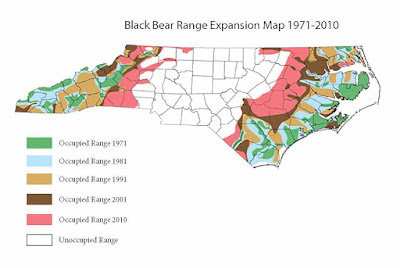BearWise basics: co-existing peacefully with black bears.
I hadn't been aware until hearing a Backyard Bears program last Sunday how strongly the black bear population had rebounded in North Carolina; this range map tells the story.
From a low of 1500-2000 bears in the 1970's, there are now close to 20,000 bears in our state. So more bears and more people mean that we're more likely to interact, so we need to learn how to better co-exist responsibly.
With an acorn failure at higher elevations in the mountains this summer, many more bears than usual have been in spotted in urban Asheville, where I live, particularly in neighborhoods that don't usually see bears in the summer. They're looking for food and being unfortunately "rewarded" by the easy pickings available in our trashcans, dumpsters, bird feeders, pet food bowls, and recycling containers.
Yes, they may also take advantage of the abundant acorns in the urban forest, or occasional fruit-bearing trees or shrubs, too, but the easy pickings are the unsecured "unnatural" foods. Bears are adaptable and smart. But they're also normally shy and wary of people; we don't want them to lose their fear of people by becoming accustomed to unnatural human foods.
The neighborhoods in the mountains and more rural communities located in more typical bear habitat are used to bears and securing their trash, not so much in our central neighborhoods near downtown, where we normally might see just a few single males wandering through in spring or early summer. (I wrote more about bear sightings this summer and fall on a previous post in Places of the Spirit.)
I was so impressed with the Bearwise program (and website) which the N.C. Wildlife Resources Commission takes part in, that I'm planning to distribute their literature and outreach materials to some of my neighborhoods and include their recommendations in upcoming gardening for wildlife programs.
Black bears are NOT inherently dangerous to humans and black bear attacks are extremely rare, in spite of what you might "hear." Black bears often walk through rural and suburban neighborhoods looking for food; ; if food and garbage are secured, they'll keep on going. According to the BearWise site, bears that get unnatural foods may eventually lose their fear of people, which can be a risk to public safety. Also, don't confuse grizzly bear behavior with black bear behavior. They're quite different animals.
So, here are the BearWise basics:
I'm planning to learn a lot more about black bear ecology and their habitat requirements; as a biologist, albeit a plant one, I'm inherently interested in promoting living harmoniously with wildlife as much as possible.
The ecological framework of our planet is dependent on these interconnections, after all, and as forests slowly came back across the Southeast (and the Eastern U.S., too), post widespread logging in the late 1800's and early 1900's, and as abandoned farm fields turned back into forest, bear habitat came back as well, so their numbers have also come back.
More about black bear ecology to come!
From a low of 1500-2000 bears in the 1970's, there are now close to 20,000 bears in our state. So more bears and more people mean that we're more likely to interact, so we need to learn how to better co-exist responsibly.
With an acorn failure at higher elevations in the mountains this summer, many more bears than usual have been in spotted in urban Asheville, where I live, particularly in neighborhoods that don't usually see bears in the summer. They're looking for food and being unfortunately "rewarded" by the easy pickings available in our trashcans, dumpsters, bird feeders, pet food bowls, and recycling containers.
Yes, they may also take advantage of the abundant acorns in the urban forest, or occasional fruit-bearing trees or shrubs, too, but the easy pickings are the unsecured "unnatural" foods. Bears are adaptable and smart. But they're also normally shy and wary of people; we don't want them to lose their fear of people by becoming accustomed to unnatural human foods.
The neighborhoods in the mountains and more rural communities located in more typical bear habitat are used to bears and securing their trash, not so much in our central neighborhoods near downtown, where we normally might see just a few single males wandering through in spring or early summer. (I wrote more about bear sightings this summer and fall on a previous post in Places of the Spirit.)
I was so impressed with the Bearwise program (and website) which the N.C. Wildlife Resources Commission takes part in, that I'm planning to distribute their literature and outreach materials to some of my neighborhoods and include their recommendations in upcoming gardening for wildlife programs.
Black bears are NOT inherently dangerous to humans and black bear attacks are extremely rare, in spite of what you might "hear." Black bears often walk through rural and suburban neighborhoods looking for food; ; if food and garbage are secured, they'll keep on going. According to the BearWise site, bears that get unnatural foods may eventually lose their fear of people, which can be a risk to public safety. Also, don't confuse grizzly bear behavior with black bear behavior. They're quite different animals.
So, here are the BearWise basics:
I'm planning to learn a lot more about black bear ecology and their habitat requirements; as a biologist, albeit a plant one, I'm inherently interested in promoting living harmoniously with wildlife as much as possible.
The ecological framework of our planet is dependent on these interconnections, after all, and as forests slowly came back across the Southeast (and the Eastern U.S., too), post widespread logging in the late 1800's and early 1900's, and as abandoned farm fields turned back into forest, bear habitat came back as well, so their numbers have also come back.
More about black bear ecology to come!


Comments
Post a Comment
I enjoy hearing from fellow nature lovers and gardeners. Let me know your thoughts.